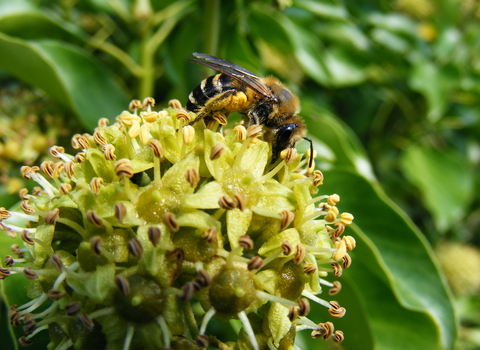
Ivy bee ©Jane Adams
Ivy bee
Scientific name
Colletes hederaeWhen to see
September to NovemberSpecies information
Category
Statistics
Length: 1.0-1.3cmHabitats
About
The ivy bee was first recorded in the UK in 2001, and has now been found in much of Southern England and Wales, and in the Channel Islands. As suggested by its common name, Ivy is the main plant used by this bee for pollen. It is seen when ivy is in flower, from early September to early November. Ivy bees nest in loose, light or sandy soil on southern-facing banks and cliffs with ivy nearby for foraging. They are solitary bees, but when conditions are suitable, there may be thousands of nests in the same area.How to identify
The ivy bee looks similar to a honey bee; it has an orangey-brown, hairy thorax, and distinct black and yellow stripes on its abdomen.Distribution
Found in Southern England and Wales, and the Channel Islands.In our area
Ivy bees were first seen in Worcestershire in 2013 and have since spread across the county. We're still tracking the spread of the bees so if you have bees emerging from your lawn or flower beds in September or October, please get in touch with Worcestershire Biological Records Centre records@wbrc.org.uk along with date and location (grid reference and/or postcode) as well as a photograph to confirm identification.
Did you know?
Ivy bees feed mainly on ivy, so they time their emergence to fit in with the flowering period of this common plant: late September to November.Ivy bees were first seen in Worcestershire in 2013 and have since spread across the county. We're still tracking the spread of the bees so if you have bees emerging from your lawn or flower beds in September or October, please get in touch with Worcestershire Biological Records Centre records@wbrc.org.uk along with date and location (grid reference and/or postcode) as well as a photograph to confirm identification.
